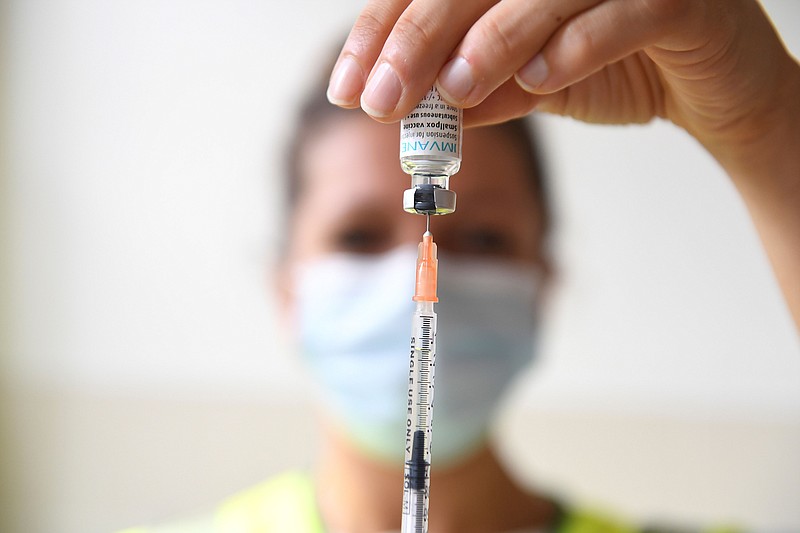TEXARKANA – Since the start of the federal response to the monkeypox outbreak on May 17, the virus is being reported in all but three states – Montana, Vermont and Wyoming.
The Centers for Disease Control and Prevention reported Friday, the most recent data, a total of 5,189 cases of the virus that can cause a painful rash and flu-like symptoms. Four cases have been reported in Arkansas and 351 in Texas.
However, certain details about the outbreak are not being made public.
"We're not able to share specifics or locations of cases," said Danyelle McNeill, public information officer for the Arkansas Department of Health. "It's for privacy reasons."
The situation is similar across the state line.
"We're not producing county-level data for monkeypox cases," said Douglas Loveday, press officer for the Texas Department of State Health Services.
Monkeypox is a rare disease in the same family as smallpox; it is unrelated to chickenpox. The virus was discovered in 1958 when two outbreaks of a pox-like disease occurred in colonies of monkeys kept for research, according to the CDC. Despite being named "monkeypox," the source of the disease remains unknown.
The first human case of monkeypox was recorded in 1970.
Monkeypox has been reported in people in several central and western African countries. The last outbreak in the U.S., in 2003, is linked to a shipment of small rodents that arrived in Texas from Ghana, according to the CDC. After importation, some of the infected animals were housed near prairie dogs at the facilities of an Illinois animal vendor. These prairie dogs were sold as pets before they developed signs of infection.
"All people infected with monkeypox became ill after having contact with infected pet prairie dogs," the CDC reports. "A study conducted after the outbreak suggested that certain activities associated with animals were more likely to lead to monkeypox infection. These activities included touching a sick animal or receiving a bite or scratch that broke the skin."
The 2003 outbreak resulted in 35 confirmed human cases in six states, according to the Texas Department of State Health Services. The outbreak was contained through a multi-part campaign of treatment with the smallpox vaccination, tracking potentially infected animals and public education on the illness.
The last confirmed case of monkeypox in the U.S. was reported by the Maryland Department of Health in 2021 when a U.S. resident returned to the country ill after a visit to Nigeria.
Symptoms of monkeypox usually start within three weeks of exposure to the virus, the CDC says. They include –
• Fever
• Headache
• Muscle aches and backache
• Swollen lymph nodes
• Chills
• Exhaustion
• Respiratory symptoms (e.g. sore throat, nasal congestion, or cough)
• A rash that may be located on or near the genitals or anus but could also be on other areas like the hands, feet, chest, face or mouth.
The rash can look like pimples or blisters and be painful or itchy. It can go through several stages, including scabs, before healing.
An infected person may experience all or only a few symptoms, but most people usually have a rash, the CDC says. An infected person who has flu-like symptoms usually will develop a rash one to four days later.
"Monkeypox can be spread from the time symptoms start until the rash has healed, all scabs have fallen off, and a fresh layer of skin has formed," the CDC says.
Preventing infection involves avoiding –
• avoiding close, skin-to-skin contact with people who have a rash that looks like monkeypox.
• avoiding contact with objects and materials that a person with monkeypox has used.
• washing hands often with soap and water or using an alcohol-based hand sanitizer, especially before eating or touching your face and after using the bathroom.
The CDC says there are two vaccines that may be helpful in the prevention of monkeypox -- JYNNEOS and ACAM2000.
JYNNEOS, also known as Imvamune or Imvanex, is approved by the U.S. Food and Drug Administration for the prevention of monkeypox virus infection. ACAM2000 has FDA approval for use against smallpox but is being made available for monkeypox under an Expanded Access Investigational New Drug applicatio, according to the CDC.
"In the United States, there is currently a limited supply of JYNNEOS, although more is expected in the coming weeks and months," the CDC says. "There is a larger supply of ACAM2000, but this vaccine should not be used in people who have certain health conditions, such as a weakened immune system, skin conditions like eczema or other exfoliative skin conditions, or pregnancy."
No data are available on the effectiveness of the vaccines in the current monkeypox outbreak, the CDC says.

